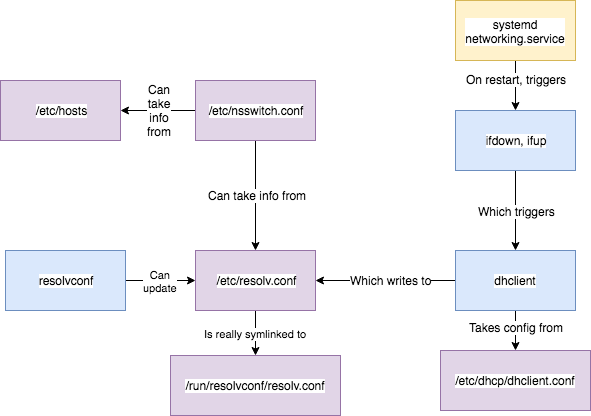In Anatomy of a Linux DNS Lookup – Part I I covered:
nsswitch/etc/hosts/etc/resolv.confpingvshoststyle lookups
and determined that most programs reference /etc/resolv.conf along the way to figuring out which DNS server to look up.
That stuff was more general linux behaviour (*) but here we move firmly into distribution-specific territory. I use ubuntu, but a lot of this will overlap with Debian and even CentOS-based distributions, and also differ from earlier or later Ubuntu versions.
(*) in fact, it’s subject to a POSIX standard, so
is not limited to Linux (I learned this from
a fantastic comment on the previous post)
In other words: your host is more likely to differ in its behaviour in specifics from here.
In Part II I’ll cover how resolv.conf can get updated, what happens when systemctl restart networking is run, and how dhclient gets involved.
Other posts in the series:
Anatomy of a Linux DNS Lookup – Part I
Anatomy of a Linux DNS Lookup – Part III
Anatomy of a Linux DNS Lookup – Part IV
Anatomy of a Linux DNS Lookup – Part V – Two Debug Nightmares
1) Updating /etc/resolv.conf by hand
We know that /etc/resolv.conf is (highly likely to be) referenced, so surely you can just add a nameserver to that file, and then your host will use that nameserver in addition to the others, right?
If you try that:
$ echo nameserver 10.10.10.10 >> /etc/resolv.conf
it all looks good:
# Dynamic resolv.conf(5) file for glibc resolver(3) generated by resolvconf(8) # DO NOT EDIT THIS FILE BY HAND -- YOUR CHANGES WILL BE OVERWRITTEN nameserver 10.0.2.3 search home nameserver 10.10.10.10
until the network is restarted:
$ systemctl restart networking $ cat /etc/resolv.conf # Dynamic resolv.conf(5) file for glibc resolver(3) generated by resolvconf(8) # DO NOT EDIT THIS FILE BY HAND -- YOUR CHANGES WILL BE OVERWRITTEN nameserver 10.0.2.3 search home
our 10.10.10.10 nameserver has gone!
This is where those comments we ignored in Part I come in…
2) resolvconf
You see the phrase generated by resolvconf in the /etc/resolv.conf file above? This is our clue.
If you dig into what systemctl restart networking does, among many other things, it ends up calling a script: /etc/network/if-up.d/000resolvconf. Within this script is a call to resolvconf:
/sbin/resolvconf -a "${IFACE}.${ADDRFAM}"
A little digging through the man pages reveals that the -a flag allows us to:
Add or overwrite the record IFACE.PROG then run the update scripts if updating is enabled.
So maybe we can call this directly to add a nameserver:
echo 'nameserver 10.10.10.10' | /sbin/resolvconf -a enp0s8.inet
Turns out we can!
$ cat /etc/resolv.conf | grep nameserver nameserver 10.0.2.3 nameserver 10.10.10.10
So we’re done now, right? This is how /etc/resolv.conf gets updated? Calling resolvconf adds it to a database somewhere, and then updates (if configured, whatever that means) the resolv.conf file
No.
$ systemctl restart networking root@linuxdns1:/etc# cat /etc/resolv.conf # Dynamic resolv.conf(5) file for glibc resolver(3) generated by resolvconf(8) # DO NOT EDIT THIS FILE BY HAND -- YOUR CHANGES WILL BE OVERWRITTEN nameserver 10.0.2.3 search home
Argh! It’s gone again.
So systemctl restart networking does more than just run resolvconf. It must be getting the nameserver information from somewhere else. Where?
3) ifup/ifdown
Digging further into what systemctl restart networking does tells us a couple of things:
cat /lib/systemd/system/networking.service [...] [Service] Type=oneshot EnvironmentFile=-/etc/default/networking ExecStartPre=-/bin/sh -c '[ "$CONFIGURE_INTERFACES" != "no" ] && [ -n "$(ifquery --read-environment --list --exclude=lo)" ] && udevadm settle' ExecStart=/sbin/ifup -a --read-environment ExecStop=/sbin/ifdown -a --read-environment --exclude=lo [...]
First, the networking ‘service’ restart is actually a ‘oneshot’ script that runs these commands:
/sbin/ifdown -a --read-environment --exclude=lo
/bin/sh -c '[ "$CONFIGURE_INTERFACES" != "no" ] && [ -n "$(ifquery --read-environment --list --exclude=lo)" ] && udevadm settle'
/sbin/ifup -a --read-environment
The first line with ifdown brings down all the network interfaces (but excludes the local interface). (*)
(*) I’m unclear why this doesn’t boot me out of my
vagrant session in my example code (anyone know?).
The second line makes sure the system has done all it needs to do regarding the bringing of network interfaces down before going ahead and bringing them all back up with ifup in the third line. So the second thing we learn is that ifup and ifdown are what the networking service ‘actually’ runs.
The --read-environment flag is undocumented, and is there so that systemctl can play nice with it. A lot of people hate systemctl for this kind of thing.
Great. So what does ifup (and its twin, ifdown) do? To cut another long story short, it runs all the scripts in etc/network/if-pre-up.d/ and /etc/network/if-up.d/. These in turn might run other scripts, and so on.
One of the things it does (and I’m still not quite sure how – maybe udev is involved?) dhclient gets run.
4) dhclient
dhclient is a program that interacts with DHCP servers to negotiate the details of what IP address the network interface specified should use. It also can receive a DNS nameserver to use, which then gets placed in the /etc/resolv.conf.
Let’s cut to the chase and simulate what it does, but just on the enp0s3 interface on my example VM, having first removed the nameserver from the /etc/resolv.conf file:
$ sed -i '/nameserver.*/d' /run/resolvconf/resolv.conf $ cat /etc/resolv.conf | grep nameserver $ dhclient -r enp0s3 && dhclient -v enp0s3 Killed old client process Internet Systems Consortium DHCP Client 4.3.3 Copyright 2004-2015 Internet Systems Consortium. All rights reserved. For info, please visit https://www.isc.org/software/dhcp/ Listening on LPF/enp0s8/08:00:27:1c:85:19 Sending on LPF/enp0s8/08:00:27:1c:85:19 Sending on Socket/fallback DHCPDISCOVER on enp0s8 to 255.255.255.255 port 67 interval 3 (xid=0xf2f2513e) DHCPREQUEST of 172.28.128.3 on enp0s8 to 255.255.255.255 port 67 (xid=0x3e51f2f2) DHCPOFFER of 172.28.128.3 from 172.28.128.2 DHCPACK of 172.28.128.3 from 172.28.128.2 bound to 172.28.128.3 -- renewal in 519 seconds. $ cat /etc/resolv.conf | grep nameserver nameserver 10.0.2.3
So that’s where the nameserver comes from…
But hang on a sec – what’s that /run/resolvconf/resolv.conf doing there, when it should be /etc/resolv.conf?
Well, it turns out that /etc/resolv.conf isn’t always ‘just’ a file.
On my VM, it’s a symlink to the ‘real’ file stored in /run/resolvconf. This is a clue that the file is constructed at run time, and one of the reasons we’re told not to edit the file directly.
If the sed command above were to be run on the /etc/resolv.conf file directly then the behaviour above would be different and a warning thrown about /etc/resolv.conf not being a symlink (sed -i doesn’t handle symlinks cleverly – it just creates a fresh file).
dhclient offers the capability to override the DNS server given to you by DHCP if you dig a bit deeper into the supersede setting in /etc/dhcp/dhclient.conf…

A (roughly) accurate map of what’s going on
End of Part II
That’s the end of Part II. Believe it or not that was a somewhat simplified version of what goes on, but I tried to keep it to the important and ‘useful to know’ stuff so you wouldn’t fall asleep. Most of that detail is around the twists and turns of the scripts that actually get run.
And we’re still not done yet. Part III will look at even more layers on top of these.
Let’s briefly list some of the things we’ve come across so far:
nsswitch/etc/hosts/etc/resolv.conf/run/resolvconf/resolv.confsystemdand itsnetworkingserviceifupandifdowndhclientresolvconf
If you like this, you might like one of my books:




Is there something like this article for how dns Is traversed in Kubernetes? KubeDNS vs CoreDNS etc?
There’s another article I wrote a while ago on DNS in OpenShift that might be relevant while you wait…
cat | grep? you can just grep, man! Nice write up!
You’re not “booted” because the commands happen in rapid succession — fast enough that your TCP connection remained intact (aside from one retransmitted packet).
If you were to put a ‘sleep 20’ in there, you’d likely get booted.
“The first line with ifup brings down all the network interfaces” shouldn’t this be ifdown?
You should write about local dns caching in part 3. It can be rather weird with timeouts, multiple retires, dual requests due to ipv4+6 etc.
Thanks – do you have useful resources on that?
Have you checked Ubuntu 18.04, for instance?
Now enters systemd-resolved to add even more to this complexity…
It is really a hell to get it to work fine with VPN, and to debug…
Dealing with an 18.04 bug that spiked cpu because systemd-resolved was fighting dnsmasq was the trigger for me to actually unpick this mess!
I also had a hard time trying to debug an issue with systemd-resolved… complexity and subtle bugs, a real pain for something as critical as name resolution.
And, great article by the way. Thanks !
once upon a time, dnsmasq plays a role in generating resolv.conf.
Hi Ian,
Thanks for your articles.
How did you find that “systemctl restart networking does, among many other things, it ends up calling a script:
/etc/network/if-up.d/000resolvconf” ?
Tried strace but only had either WSL (no no systemd) or Linux 18.04 which seems a little bit different.
Many thanks
strace won’t help you – I think I did a system-wide check of which files were opened while the command was running using sysdig I think
Thanks Ian, I will have a check.
Unrelated, but I see it all too often: These two are equivalent:
cat /etc/resolv.conf | grep nameserver
grep nameserver /etc/resolv.conf #no need to cut and pipe
Cheers
^^ “So systemctl restart networking does more than just run resolvconf. It must be getting the nameserver information from somewhere else. Where?” ^^
On Debian Systems take a look at /etc/network/interfaces for local network configuration.
Either a “nameserver” statement or “dhpc” advise if-up which nameserver to put in resolv.conf.